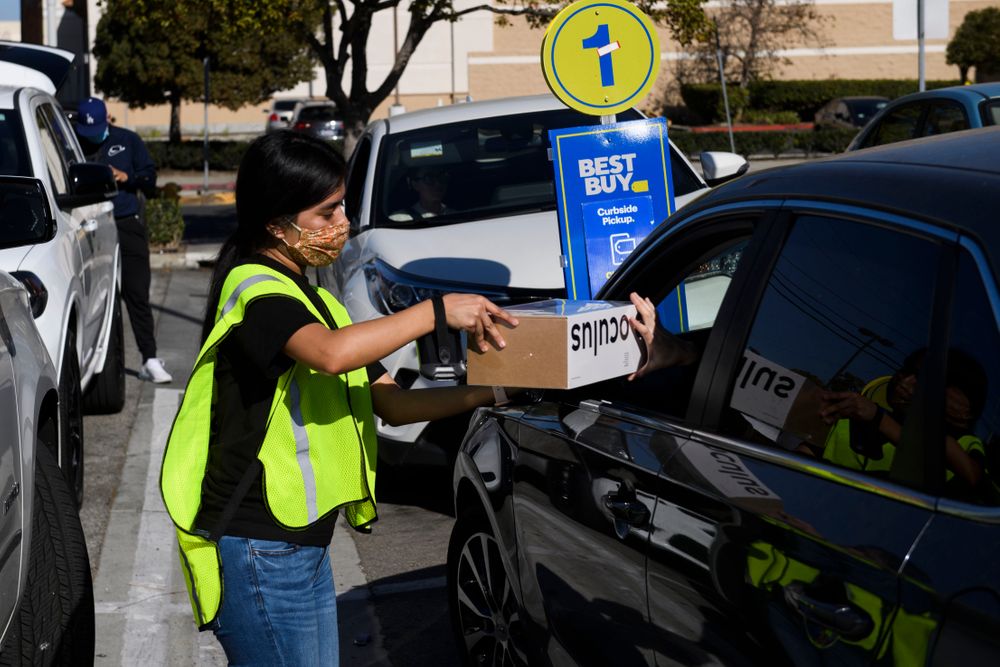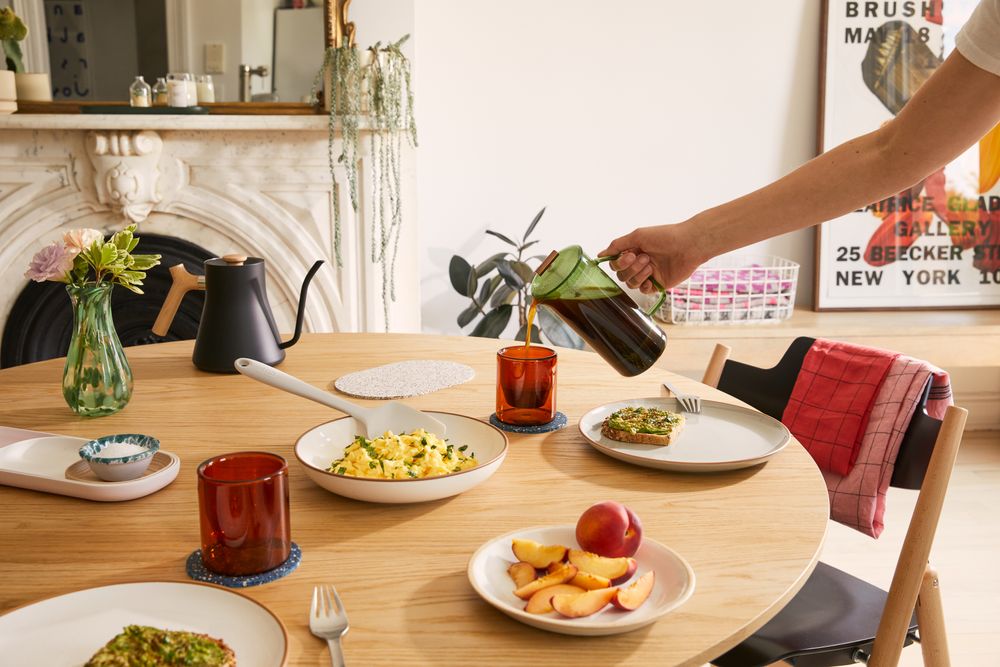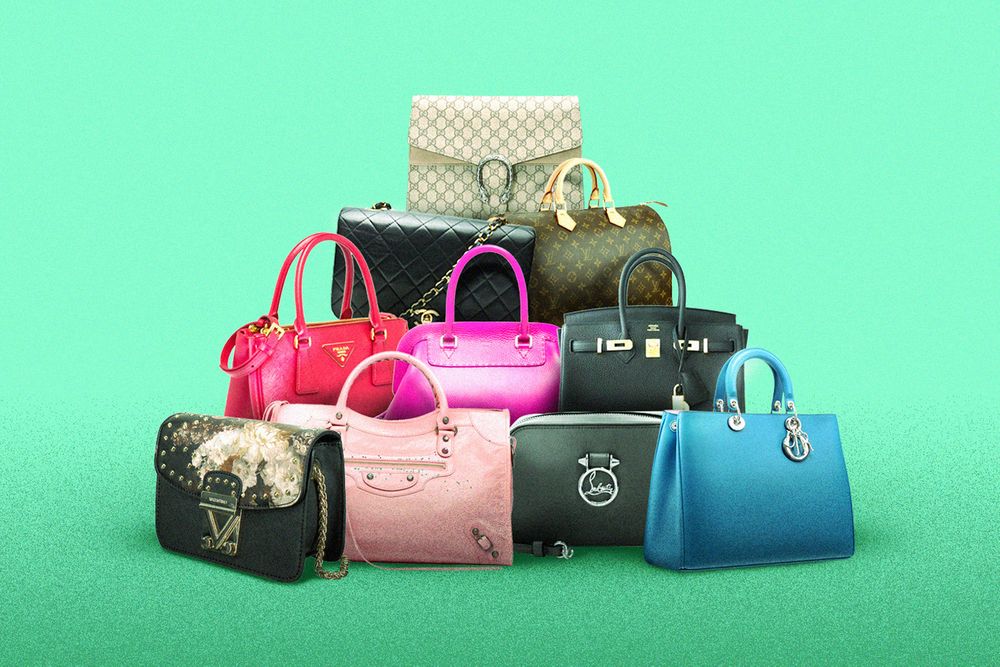|
Vibe check: How are our friends in e-comm hanging amid [gestures at the lines outside Louis Vuitton]?
Better than expected: EMarketer today revised its 2021 US e-comm forecast, anticipating online sales will grow 18% this year to reach $933 billion (versus the 13.7% predicted in January).
In today’s edition:
- The changing retail workforce
- Pattern acquires DTC brands
- Mytheresa moves into resale
—Halie LeSavage, Katishi Maake, Julia Gray
|
|

Patrick T. Fallon/Getty Images
|
It’s been hammered into our brains for the past 14 months: The pandemic has forever changed retail. There’s curbside pickup, self-checkout, e-comm fulfillment—the list goes on.
But these innovations have done more than speed up delivery times. They’ve redefined the role of the retail worker, who is no longer solely tasked with operating the cash register or stocking shelves.
One clear example is BOPIS, a pandemic habit that shoppers immediately picked up.
- Click-and-collect spend in the US hit $72+ billion in 2020, up ~107% over 2019, per eMarketer.
Fulfilling online orders and carrying them to the curb became part of the job description—and it looks to stay that way.
2021 vision: Best Buy CEO Corie Barry, for example, said in a May earnings call that store employees are “becoming an increasingly important aspect of our delivery experience.”
- ~60% of its Q1 online sales were either picked up or sent from, or delivered by someone working in a store.
- The company is also testing same-day home delivery by in-store employees.
Best Buy’s also had to consider the size of its labor force, given pandemic shifts. In February, it laid off ~5,000 employees, decreasing its headcount by 17% compared to the start of 2020, per Modern Retail.
- But it turned more part-time roles into full-time positions; the latter now make up 60% of employees versus 54% pre-pandemic.
Smaller retailers, too, have had to make adjustments.
Loyalty, loyalty, loyalty
Madison Reed, a DTC hair color startup, intended to expand its brick-and-mortar presence before the pandemic hit. On March 13, 2020, it closed its 12 stores, and CEO Amy Errett had to figure out what to do with 200 employees, she told Retail Brew.
Luckily, business exploded. The company needed every set of hands it had.
- “We’re not firing these people; we have to hold onto those assets. Let’s put them in a call center if that’s what they want to do because...we were selling a box of hair color every five seconds,” Errett told us.
She said colorists started handling customer service and working on product development—anything and everything to keep things moving. That’s still the case as the company resumes its IRL plans, Errett added.
Click here to read more about how the retail workforce has changed for good.—KM
|
|

Pattern Brands
|
Two years after rebranding from DTC agency to DTC incubator, Pattern is once again hitting refresh on its strategy. The vibe this time? Millennial-centric Williams-Sonoma.
Betting on the great indoors, Pattern is now a DTC holding company for home goods brands. The move is backed by $60 million in debt and equity capital from existing and new investors, including Kleiner Perkins, RRE Ventures, and Primary Venture Partners.
- The funding follows Pattern’s $14 million Series A in 2019. Pattern is not yet profitable.
Roll-up roll call: Pattern plans to acquire between 10 and 15 DTC home goods brands “over the next few years,” Chief Business Officer and cofounder Suze Dowling told Retail Brew.
- Pattern already purchased one to make the move official: GIR, short for “Get It Right,” a profitable kitchen line with ~50 products.
Small businesses hunting for experienced management and better branding chops started reaching out to Pattern last year, cofounder and Executive Creative Director Emmett Shine told us.
It benefits Pattern, too. Acquisitions mean the company can leverage existing supply chains to enter new categories, Dowling said—which is a lot speedier than building a house of 10+ brands from scratch. Pattern has released two in under two years so far: Equal Parts (cookware) and Open Spaces (organization goods).
- Very Great and Win Brands are also building DTC hubs to sidestep product development challenges.
Looking ahead...reopening efforts won’t diminish the home goods world’s recent winning streak—an encouraging sign for Pattern’s new layout. “People are going to think more about their relationship with the items they have,” Shine said. “I don't think that changes if people go to the gym or office more.”—HL
|
|
SPONSORED BY YOTPO
There’s No Crystal Ball For Marketers…
|

|
But there is a checklist—and it answers the age-old question of whether or not SMS marketing is right for your brand.
Yotpo’s comprehensive checklist is just what you need if you’re considering SMS marketing but just aren’t sure if it’s the right channel for you. Their easy-to-follow checklist addresses the main hesitations SMB brands might have around SMS, including:
- Is my audience right for SMS?
- How much effort will maintaining an SMS marketing channel take?
- How will SMS affect my other marketing channels?
With over 48% of consumers already signed up to receive texts from a brand, there’s never been a better time to overcome your SMS hesitations and adopt a SMS marketing strategy—it might just be a lot easier than you think.
Check out the checklist today.
|
|

Francis Scialabba
|
If it ain’t broke, resell it. That seems to be retail’s new motto.
Mytheresa is the latest to hop on the (gently used) bandwagon. The luxury retailer is rolling out a new handbag resale service today, in partnership with consignment platform Vestiaire Collective.
- Mytheresa will let select customers exchange their pre-loved purses for store credit.
No second thoughts: As the pandemic’s impact lingers on the retail industry, the secondhand market, which is expected to grow to $64 billion by 2024, per Statista, has become an increasingly attractive option.
“Retailers are looking at resale as a source of growth within the flat or negative industry,” Kearney principal analyst Alex Fitzgerald told Retail Brew. Just count the announcements in the past week or so:
- Etsy bought Gen Z favorite Depop for $1.6+ billion; CEO Josh Silverman pointed to the move as a way to offset a return to in-store retail.
- Rent the Runway is looking to court new customers with a resale service (no sub required), and Stitch Fix is also considering secondhand.
That new new: “It’s less about converting the traditional luxury buyers,” Fitzgerald said, and more about acquiring new ones. Discounts mean retailers like Mytheresa can broaden their consumer bases.
- ~40% of Gen Z shoppers bought something secondhand in 2019—the highest percentage of all age groups—according to a study by ThredUp.—JG
|
|
-
Best Buy will close on Thanksgiving Day, following fellow big-box players Walmart and Target.
-
Gap dropped its first Yeezy product, a $200 puffer jacket.
-
Microsoft is returning to physical retail with new “experience centers.”
-
Chipotle is raising its menu prices by 4% to pay for higher hourly wages.
|
|

|
It’s not magic — it’s data. Specifically, it’s a customer data platform (CDP) that’s the perfect fit for your business. Bloomreach has the e-book to take your company to the next level and help you to understand how to choose the right CDP. Learn what makes CDPs different from other software. Download the guide today.
|
|
|
Today’s top retail longreads.
High-stepping: Shoppers are dressing up again, and bringing high heels back from the brink of extinction. (NYT)
Zero waste: Grocers are finding ways to give “ugly produce” new life in an effort to cut back on food waste. (Fortune)
Rise to the top: Former Ulta CEO Mary Dillon stepped down this month, but under her leadership, she transformed the regional chain into a countrywide force. (Retail Dive)
|
|

Francis Scialabba
|
On Wednesdays, we wear pink spotlight Retail Brew's readers. Want to be featured in an upcoming edition? Click here to introduce yourself.
Since sliding into your inboxes nearly two (!) years ago, Retail Brew has found readers all over the world: South Korea, Brazil, New Zealand, and today, Singapore. That’s where our featured reader, Aadi Vaidya, COO of B2B fashion platform Zilingo, is based.
One thing about your job that we can’t guess from LinkedIn: A critical part of my job is to be a bridge between the teams on the ground and the shareholders of the company. I sit in board meetings and also sales calls [with suppliers].
Favorite project you’ve worked on: Enabling the procurement of organic cotton for one of the largest global fashion brands from India.
Name a brand (or two) we should follow: MaisonCléo and Maison Flâneur.
What’s an emerging retail trend you’re bullish on? Digital procurement. Due to Covid, the pace at which brands adopted digital procurement has accelerated manyfold—it removes the risk of traveling and having multiple remote offices, and it provides transparency and real time production information.
|
|
|
Enjoying the newsletter? Share it with your network to take advantage of our rewards program.
When you reach 3 referrals, you'll be invited to Monthly Exclusive Events with our co-founder Alex and the biggest names in business.

Hit the button below to learn more and access your rewards hub.
Click to ShareOr copy & paste your referral link to others:
morningbrew.com/retail/r/?kid=303a04a9
|
|
|
Catch up on the Retail Brew stories you may have missed.
|
|
|
Written by
Halie LeSavage, Julia Gray, and Katishi Maake
Was this email forwarded to you? Sign up here.
|
ADVERTISE // CAREERS // SHOP // FAQ
Update your email preferences or unsubscribe here.
View our privacy policy here.
Copyright © 2021 Morning Brew. All rights reserved.
22 W 19th St, 8th Floor, New York, NY 10011
|
|










